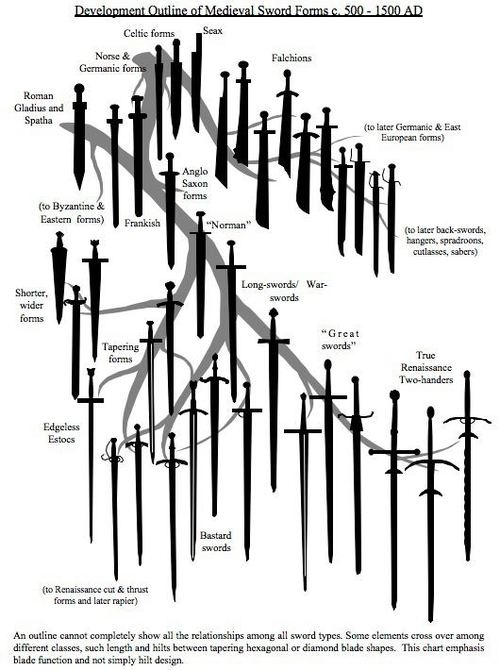Every time I see a Medieval period movie, series or documentary, the mais weapon shown is the sword. However, if you think about it, you notice that swords were very difficult to create and required a skilled specialist to forge and maintain.
Although a blacksmith worked with soft iron, a swordsmith or bladesmith had to take numerous steps to heat iron into steel and forge the blade properly before polishing and cleaning. A separate skilled laborer -- called a hiltmaker -- would fashion the handle of the sword, so you get an idea of how complex it is. As you can see in the picture above, Medieval swords appeared in a variety of forms, but generally had a long, wide, straight, double-edged blade with a simple cross-guard (or "cruciform" hilt).
Daggers and knives, however, were made of steel and widely carried as a secondary weapon to be used alongside the sword in close combat. But knights weren't the only ones who wielded these weapons. Given how easy it is to produce even a rudimentary blade, they were commonly used as a form of personal protection.
Although a blacksmith worked with soft iron, a swordsmith or bladesmith had to take numerous steps to heat iron into steel and forge the blade properly before polishing and cleaning. A separate skilled laborer -- called a hiltmaker -- would fashion the handle of the sword, so you get an idea of how complex it is. As you can see in the picture above, Medieval swords appeared in a variety of forms, but generally had a long, wide, straight, double-edged blade with a simple cross-guard (or "cruciform" hilt).
Daggers and knives, however, were made of steel and widely carried as a secondary weapon to be used alongside the sword in close combat. But knights weren't the only ones who wielded these weapons. Given how easy it is to produce even a rudimentary blade, they were commonly used as a form of personal protection.
~Ally

 RSS Feed
RSS Feed